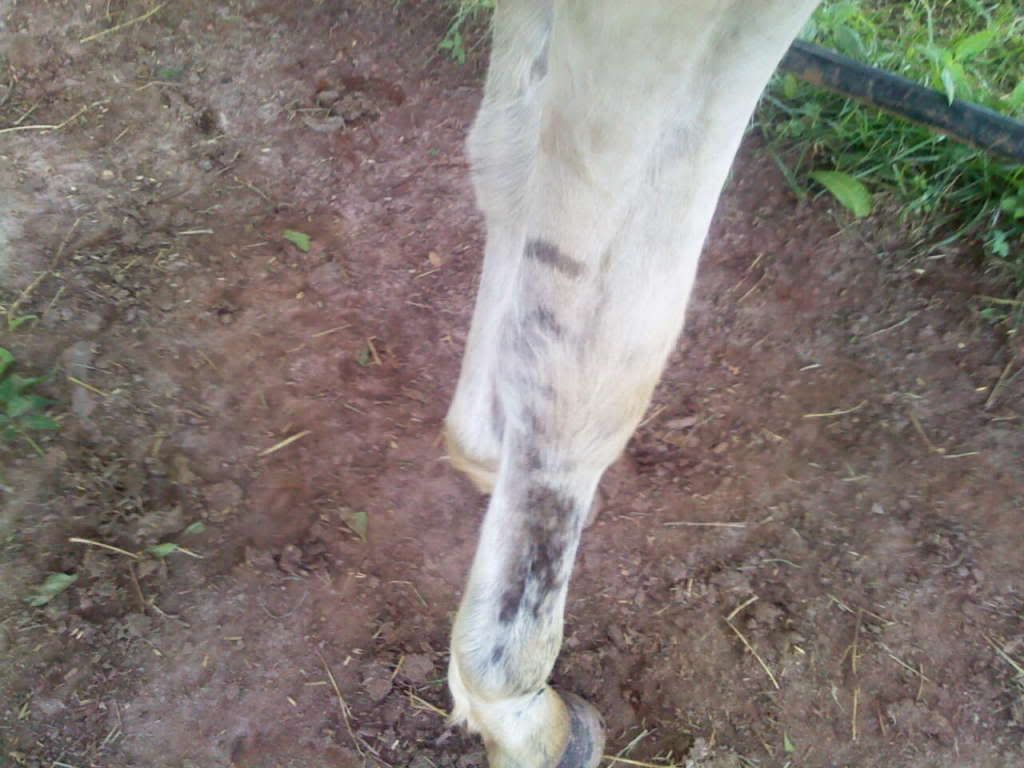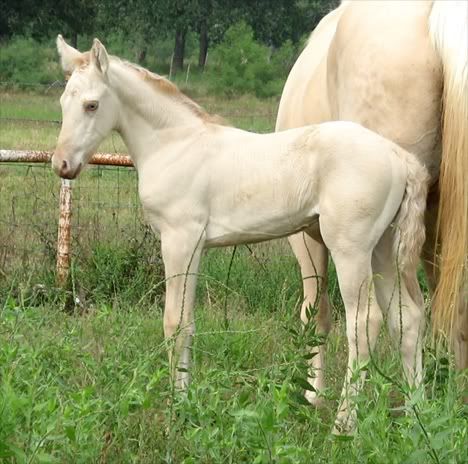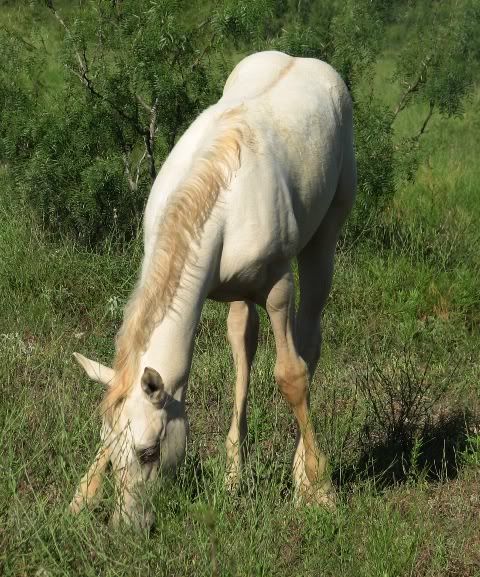|
|
Post by angelsdream on Jul 1, 2011 9:46:07 GMT -5
Here's a shot of Lakota and Cruz, and I know he inherited his stripes from her.  Cruz  |
|
|
|
Post by nrly on Jul 1, 2011 19:38:43 GMT -5
nugget for took after his Dam, leg stripes are coming through, red line down his back..so on my end yes he took more after Stormy...
|
|
|
|
Post by sbutter on Jul 2, 2011 9:47:47 GMT -5
I have also heard several other theories from kiger breeders and owners over the years. One suggestion was to breed to a grulla every so often, because that is what brought the stripes out. If that were the case, I think we would be seeing a lot more bold striped kigers than we are, since quite a few kigers have a grulla relative in their close family. I have also heard that breeding to a solid black leg would bring out the stripes in the offspring. Has anyone experienced a loss of stripes by breeding a lighter color to a lighter color?
|
|
|
|
Post by sbutter on Jul 2, 2011 13:34:33 GMT -5
Now that I think about, I have also seen some kiger crosses that had outstanding dun markings when the sire was dun and the mare was a bay. Their markings even seemed to outdo the sire's markings. I don't know how many bay kiger mares or stallions have been bred, but it would be interesting to know if they had dun offspring and if that offspring had a lot of stripes. Someone should keep an eye out for any bay mares that come in with foals at their sides at this coming adoption.
|
|
|
|
Post by DianneC on Jul 2, 2011 18:52:38 GMT -5
There is a strong suspicion that the dun gene is a cluster of genes. If that is true then things can get "lost" when the dna unravels to make the egg or sperm. It could be the base coat color that helps stripes stand out more, but its doesn't sound right. Best stripes I ever saw were on a QH mare who also threw solid foals, so one dun gene was doing all that! But her dun foals didn't have the markings she did for some reason.
Its interesting that as fewer Lusitanos are grey that the dun gene is showing up in them. Probably was there all along, just couldn't see it because they greyed out.
|
|
|
|
Post by Michelle Clarke on Jul 2, 2011 21:21:44 GMT -5
Dianne, I totally agree with the dun genes being a cluster and therefore can also be incomplete. I've seen other breeds with the cream gene for instance, that show no stripes but test positive and produce striped offspring. I also think they act funny with the sooty gene and maybe even the agouti...I will be keeping both of Nesas' fillies that are basically brown appearing. I plan on breeding them to non-dun Lusitanos and seeing what we can produce.
Reading over this, it seems that maybe the dun genes will react different with other modifiers or dilutes; but is pretty straight forward with the two base colors - being black or red.
|
|
|
|
Post by DianneC on Jul 3, 2011 0:01:10 GMT -5
Absolutely, look at how crazy the Kiger claybank thing was. I know Bettye and I tried to figure it out. We searched the internet and would send pictures to each other of dun + roan or whatever looked similar to the claybank foals. Turns out that the dun gene and grey gene produce gorgeous cream or silver colored foals with great dark markings and points. Incredibly beautiful. Every other grey horse was born dark and then greyed out. The thing is that there are still not that many dun horses around to watch how it effects other genes. There are some QHs and Morgans, even some with really good color and markings. But they are rare still.
Michelle, so many Lusitanos are sooty! Its surprising really. The cream gene horses you're talking about were double dilutes and tested by UC Davis or some place similar? And without any stripes they tested positive? Hmm, maybe there is something to the test after all. I figured if they needed pictures of the parents they couldn't have a very good test, but maybe they are doing research with them.
Angel, I keep meaning to tell you how much I like Lakota, especially her hip.
|
|
|
|
Post by Michelle Clarke on Jul 3, 2011 6:29:12 GMT -5
I also think the sooty gene is responsible for a grey that dapples instead of fades gradual or get flea bitten... Most of the tested ones that did not appear to have stripes but tested positive were single creams like palominos and buckskins. Some where double though - it is hard to tell on them. I have two by my champagne/cream QH mare; she is red based, then palomino and champagne (she's been tested). She had a pure QH colt when she first came here; he's been tested and he is the only horse to date that on file with the Champagne Registry that is perlino (double cream on bay), champagne and dun.   You could clearly see his stripes as a foal and even as he got a little older - Lynn sold him as a yearling so I have no idea what he looks like now. His sire is a sooty buckskin w/dun. He had trouble with his eyes, being squinty and some vision issues. I believe it was because of all the dilutes and also I discovered that the champagne horses have reticulated eye patterns, just as their coat - so that could most likely have something to do with it on top of all the dilutions. Our champagnes with only one cream or no cream do not have those issues. Then Morgan had a colt by Charro, Fabio, who appears palomino - though you can see his stripes at certain times of the year.  Next was Tika, who has the champagne (blue eyes turning amber) and clearly is dun. She is red based, so red dun turning champagne. The red based horses that turn appear palomino for all general purposes. The champagne washes out their manes and tails but not the body color so much. Her legs and her dorsal are very dark against her body color so I don't believe she has the cream. She looked like a light red dun when she was born and you can see by the time she was a weanling, her red mane was growing out but her point were still dark, as they are now.   This year she had Nivea - another full sibling to Fabio and Tika. She appears to be red based, cream, champagne and dun - due to how light she is. When she was born, her ear tips were dark, plus a little lower face mask and then some darkening around the eyes. As of late, now that she is shedding out, her darker areas are harder to see. I believe she has the dun because the palomino and champagnes are usually not this light so there has to be another dilution at work.   Fun stuff! |
|